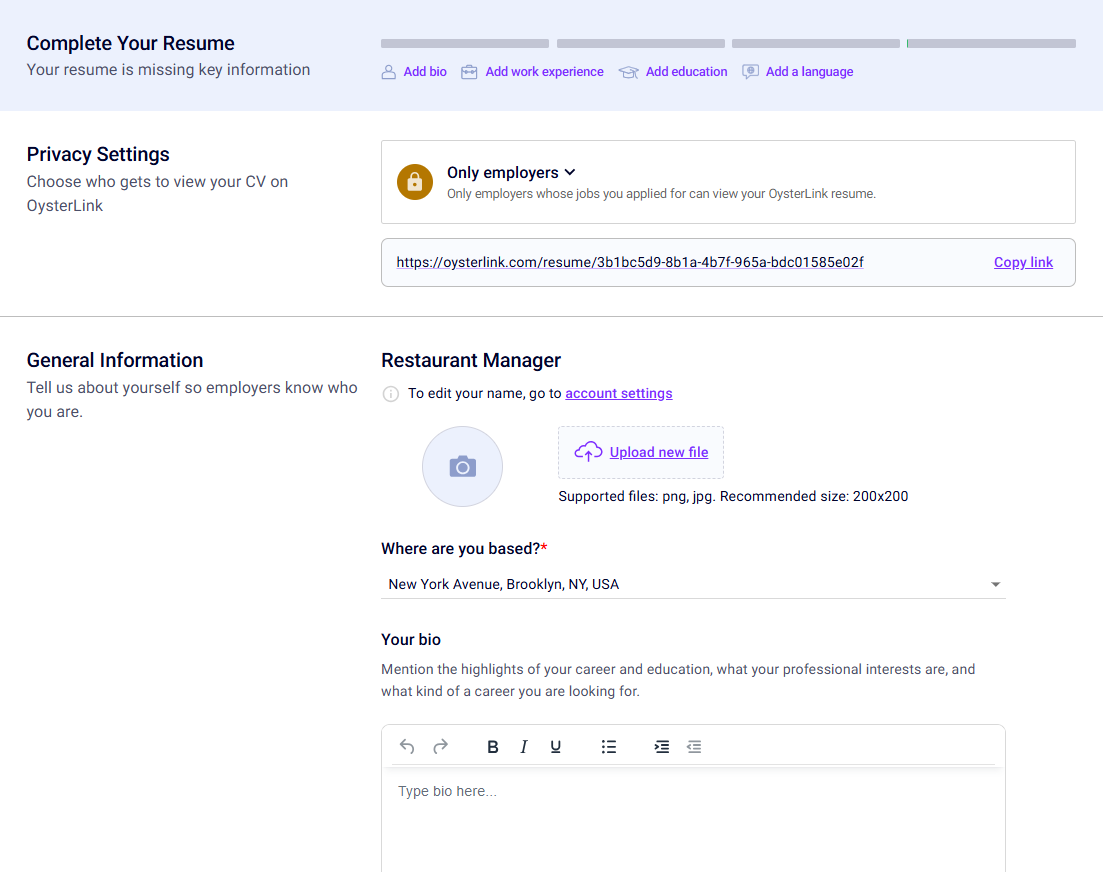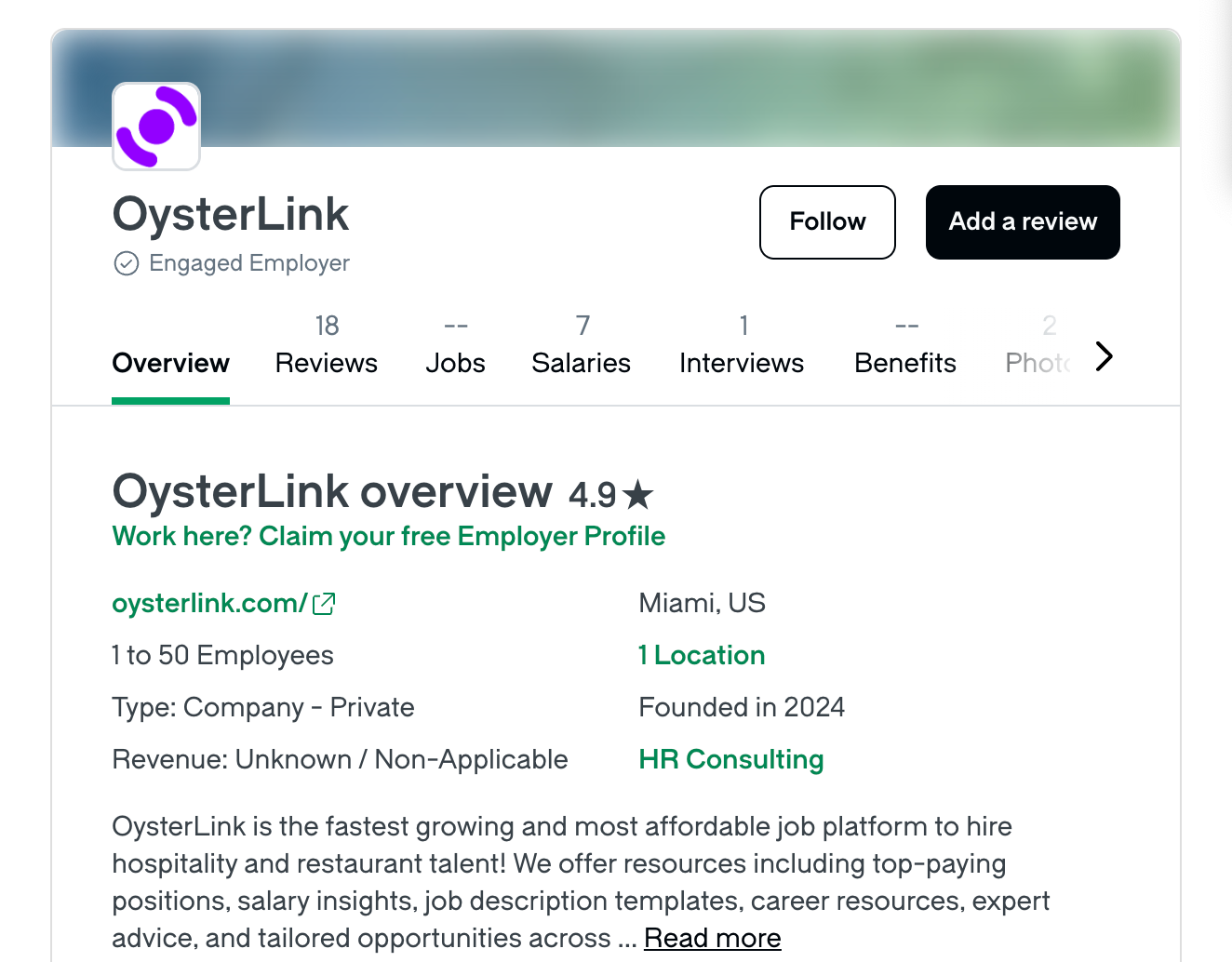Find Restaurant Manager Jobs in the U.S.
Looking for Restaurant Manager jobs? You're in the right place — with 500+ of openings across the U.S., Restaurant Manager opportunities are everywhere.
How To Apply for Restaurant Manager Jobs
Applying for a Restaurant Manager job can be competitive, but taking the right steps will greatly improve your chances.
1. Build a Professional Restaurant Manager Resume
Create a strong resume that showcases your leadership, operational knowledge, and service experience.
Highlight your expertise in staff management, customer service, budgeting, and any awards or recognitions. Include relevant certifications (e.g., ServSafe Food Protection Manager) or a hospitality management degree to stand out.
Register an account on OysterLink to access an easy-to-use resume builder for Restaurant Managers.

When using our resume-building tool, make sure to:
- Fill in all details: Add your bio, work history, certifications (e.g., ServSafe, hospitality management courses), education, and languages to boost visibility.
- Set privacy: Choose who can view your resume — public or applied employers only.
- Upload a photo: Add a clean, professional headshot (PNG/JPG, 200×200 px).
- Update location: Make sure your city is accurate so local employers can find you.
- Write your bio: Briefly highlight your skills, experience, and the type of Restaurant Manager role you're seeking.
2. Tailor Each Restaurant Manager Application
83% of recruiters are more likely to hire candidates who submit customized resumes. That said:
Don’t send the same resume and cover letter to every job.
Mirror the job description and highlight relevant management or operational expertise.
Mention the restaurant by name and why their dining concept and reputation excite you.
A tailored application helps you stand out in a competitive Restaurant Manager job market.
3. Prepare for Restaurant Manager Job Interviews
Before any management-focused interview, practice discussing your leadership background, management philosophy, and how you handle team and guest interactions.
Tailor your strengths to the setting you're applying to.
- Review the job listing and the restaurant’s menu, concept, and style.
- Share examples that demonstrate your leadership, problem-solving abilities, or innovations that improved operations.
- Be ready to discuss how you handle challenges and ask thoughtful questions about staff management, service standards, and business goals.
- Highlight your flexibility and interpersonal skills — key traits in running a successful, guest-focused restaurant.
Here are some commonly asked questions and sample answers for Restaurant Manager interviews:
Why Work as a Restaurant Manager in the U.S.?
Becoming a Restaurant Manager in the United States is a respected career path that combines leadership, business savvy, and creativity in a growing hospitality field.
With restaurants evolving to deliver exceptional experiences, the role of a Restaurant Manager has never been more essential — or more rewarding.
Strong Job Growth and Rising Demand
Across the U.S., the hospitality industry remains a powerhouse of employment. In fact, about 1 in 10 U.S. workers are employed in the restaurant and foodservice secto, highlighting the vast scope of this field.
The industry is booming – it surpassed $1 trillion in annual sales for the first time in 2023. For management roles, the Bureau of Labor Statistics projects a steady need for food service managers, with roughly 44,500 openings each year over the next decade.
This sustained demand is driven by growth and the continual need to replace retiring managers or those moving up, ensuring plenty of opportunities for new Restaurant Managers.
Vast Opportunities in a Thriving Industry
Beyond traditional restaurants, Restaurant Managers are needed in hotels, resorts, cruise ships, catering companies, and corporate dining services. The skill set is highly transferable across the hospitality sector. According to industry data, well over 700,000 restaurant establishments operate across the country.
There’s a huge range of venues—from neighborhood bistros to national chains—seeking strong managerial talent.
There are approximately 713,000 restaurants in the U.S. in total; here’s how they are distributed by state (showing where many of the opportunities lie):
| State | Restaurant Count | % of Total |
|---|---|---|
| California | 85,779 | 12% |
| Texas | 56,739 | 8% |
| New York | 49,510 | 7% |
| Florida | 48,354 | 7% |
| Pennsylvania | 26,626 | 4% |
| Illinois | 26,543 | 4% |
| Ohio | 24,821 | 3% |
| North Carolina | 23,471 | 3% |
| Georgia | 22,915 | 3% |
| New Jersey | 20,373 | 3% |
| Michigan | 19,984 | 3% |
| Virginia | 16,930 | 2% |
| All other states | ~312,840 | 43% |
| Total U.S. Restaurants | 713,885 | 100% |
Competitive Salaries Across the Country
A Restaurant Manager’s compensation reflects their experience and the establishment’s level.
National data compiled from industry reports show that entry‑level assistant managers often earn between $40,000 and $50,000 annually, while experienced Restaurant Managers with several years of experience typically average $55,000 to $70,000 per year.
In high‑cost, hospitality-centric markets, the pay climbs even higher:
- New York City: Senior restaurant managers often make around $80,000–$100,000, especially with bonus structures tied to sales and performance.
- San Francisco: Positions in upscale restaurants or luxury hotels average about $80,000 and can reach into six figures for seasoned managers.
- Miami and Chicago: Salaries typically range from $60,000 to $85,000, with additional benefits such as performance bonuses, profit-sharing, and comprehensive health benefits.
Performance incentives are common in this field.
Many establishments offer bonuses based on revenue growth or cost control, profit‑sharing programs, and perks like health insurance, retirement plan matches, or reimbursement for professional development (for example, paying for advanced hospitality courses or management certification programs).
Restaurant Manager Career Progression
Mapping out a Restaurant Manager career means understanding how skills, education, and experience can lead to higher positions and pay. Below is a clear path showing each step in the journey and the typical salary ranges you can expect at each level.
Entry‑Level: Shift Leader / Supervisor
What you do: Oversee a shift or section of the restaurant, assist the manager, train new waitstaff, and ensure quality service during your watch. Often you still perform serving or host duties while handling minor managerial tasks.
Typical salary: $35,000 – $45,000 per year (often includes hourly wages plus tips or overtime pay).
Junior Restaurant Manager / Assistant Manager
What you do: Manage daily operations under the general manager’s guidance. You might handle staff scheduling, inventory ordering, opening/closing procedures, and resolve customer service issues. This role builds your expertise in all operational areas.
Typical salary: $45,000 – $55,000 per year, plus possible quarterly or yearly performance bonuses.
Restaurant Manager (Full Role)
What you do: Also known as the General Manager, you take full charge of a restaurant’s operations.
This includes hiring and training staff, crafting budgets, negotiating with vendors, maintaining quality and safety standards, and ensuring guests have an excellent experience. You set the tone for the business and are accountable for its performance.
Typical salary: $60,000 – $75,000 per year; high‑volume or fine-dining restaurants may push toward $80K with performance incentives.
Head Restaurant Manager / District Manager
What you do: In this advanced role, you might oversee multiple outlets or a large restaurant as the top manager. You lead management teams, control budgets across units, implement company-wide policies, and ensure each location meets its targets.
For example, as a District Manager for a restaurant group, you’d travel between locations to supervise and support individual store managers.
Typical salary: $80,000 – $95,000 per year, often with bonus structures tied to regional sales and profitability.
Director of Operations / Vice President of Restaurant Operations
What you do: Top-tier leadership — you’re setting strategy and overseeing a portfolio of restaurants or an entire hospitality division.
In this executive-level position, you might develop growth plans, optimize finances across all units, and shape the brand’s direction. Many in these roles also engage in consulting or broader business development for the company.
Typical salary: $100,000 – $150,000+ per year, with many earning profit-sharing, stock options, and other executive perks.


